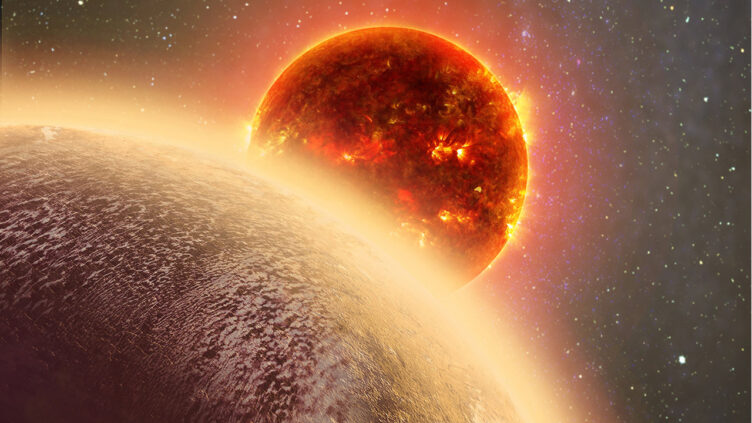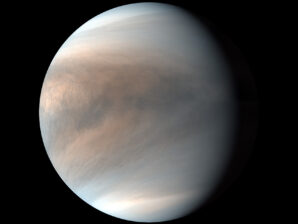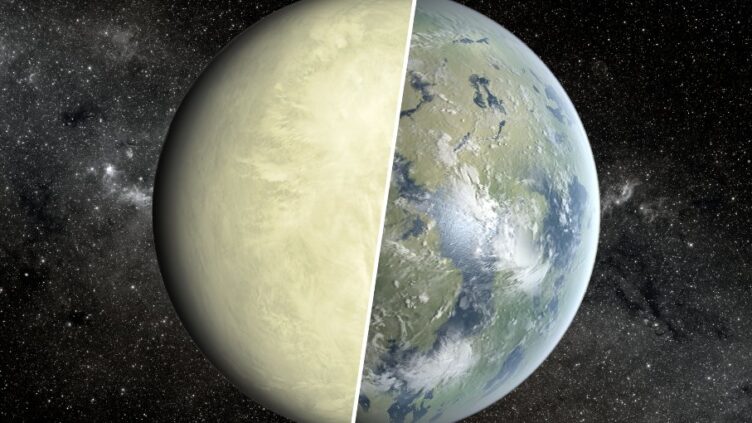The Venus atmosphere may be used as a natural laboratory to understand the evolution of Earth-like planets, according to a study led by the Instituto de Astrofísica e Ciências do Espaço (IA)
Venus and Earth are located in nearly the same region of the Solar System and have similar sizes and densities, but their atmospheres and conditions at the surface are radically different. If observed at a distance of 100 light-years, how could we set them apart?
A team of researchers chose a planet 106 light-years away, with 1.37 times the diameter of the Earth, discovered in 2022, to present the first simulation in three dimensions of the climate of a rocky planet with the properties we now see on Venus. The planet, with the name LP 890-9 c, orbits its star at a distance that places it in the habitable zone1, but very close to the limit for a runaway greenhouse effect2 that we see on Venus. The results of the simulation of this hypothetical exo-Venus were presented by an international team led by Diogo Quirino, of the Instituto de Astrofísica e Ciências do Espaço (IA), and Gabriella Gilli, collaborator of IA and researcher at the Instituto de Astrofísica de Andalucía (IAA–CSIC), in a paper3 in the journal Monthly Notices of the Royal Astronomical Society.
“It is thought that the inner limit of the habitability zone might be extended, which means that an atmosphere like that of Venus is possible in the habitability zone and that this zone is not at all a guarantee of the existence of oceans and life.”
Diogo Quirino
The potential for this planet to be like Venus makes it an ideal target for studies that aim to understand the atmospheric evolution of Earth-like planets and explain the climatic divergence that we observe today between Earth and Venus. This simulation, which used a physical-mathematical model of the global circulation of the atmosphere, first developed in the Laboratoire de Météorologie Dynamique – LMD, in France, will help prepare observations for this and other rocky planets with the instruments of the James Webb Space Telescope (JWST), and the future Extremely Large Telescope (ELT), among others.

“This 3D model is intended to support the interpretation of future observations by those instruments, which will enable us to better characterize what we see in the atmosphere of this type of planets once the observations become available,” says Diogo Quirino, who started this work still as MSc student in Geophysical Science at the Faculty of Sciences of the University of Lisbon (Ciências ULisboa). “The simulations here presented, applied to this exoplanet, are the first step towards that characterization, which implies the prediction of the temperature and atmospheric circulation and how these influence the observations.”
LP 890-9 c orbits along the inner limit of the Habitable Zone of a red dwarf, a star smaller and cooler than the Sun. However, in an earlier phase of the star, this planet may have received a level of radiation with implications for the evolution of a possible atmosphere. “It is thought that the inner limit of the habitability zone might be extended,” says Diogo Quirino, “which means that an atmosphere like that of Venus is possible in the habitability zone and that this zone is not at all a guarantee of the existence of oceans and life.” Gabriella Gilli adds: “The idea of this work is to be prepared when we detect a Venus analogue, that we are capable of recognizing it as such.”

On the basis of the hypothesis that the climate at LP 890-9 c evolved into a modern Venus-like atmosphere, the authors simulated it with a surface pressure 92 times higher than on the Earth, a chemical composition dominated in 96.5% by carbon dioxide and a global blanket of acid sulfuric clouds. Earlier studies indicate in fact that the accumulation of carbon dioxide in the atmosphere is one of the likely scenarios of evolution of Earth-like planets orbiting red dwarf stars. The team thus offers predictions for the temperature and wind speeds on the top of the clouds, as well as the number of observations needed for the characterization of the atmosphere of this planet.
“One of the capabilities of the 3D models is the calculation of the radiation emitted by the planet in certain regions of the electromagnetic spectrum,” says Quirino. The researcher calculated how the infrared radiation emitted by the planet may vary throughout its orbit, which might produce patterns that were associated with the presence of an atmosphere. “This observable allows us to predict how the radiation coming from the planet varies with time for an observer on Earth, which enables us to infer how the energy is distributed in the atmosphere of the planet.”

Credits: Diogo Quirino / ESO (estrela ao centro)
It is not yet known if there are exo-Venus, but models and 3D simulations, informed by the knowledge available about the Solar System, are essential for scientists to have useful and operational tools in the moment extrasolar planets are discovered. Diogo Quirino is already analyzing the exoplanet TRAPPIST-1 c, 39 light-years away, a study-case for a possible exo-Venus, the researcher says. “We will also produce a matrix of Venus-like planets, where we vary their properties, like the radius, gravity, atmospheric pressure or the tilt of the axis of rotation, to study the impact of these properties on the atmosphere and the climate.”
Notes
- The Habitable Zone is a region around the star where the temperature is moderate enough for the existence of water in the liquid state on the surface of the planet.
- The limit for a runaway greenhouse effect, for a planet like Earth, is the orbital distance established by simple atmospheric models at which the stellar radiation received by the planet leads to the evaporation and consequent loss of water from the surface, which produces a climate more similar to that of Venus.
- The article “3D Global climate model of an exo-Venus: a modern Venus-like atmosphere for the nearby super-Earth LP 890-9 c”, by D. Quirino, G. Gilli, et al., was published in the journal Monthly Notices of the Royal Astronomical Society, Volume NN (DOI: 10.1093/mnrasl/slad045).
Contacts
Sérgio Pereira; Ricardo Cardoso Reis; Filipe Pires (coordination, Porto); João Retrê (coordination, Lisboa)


